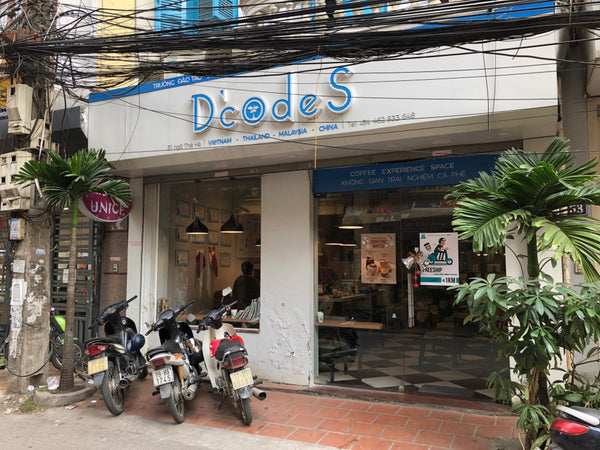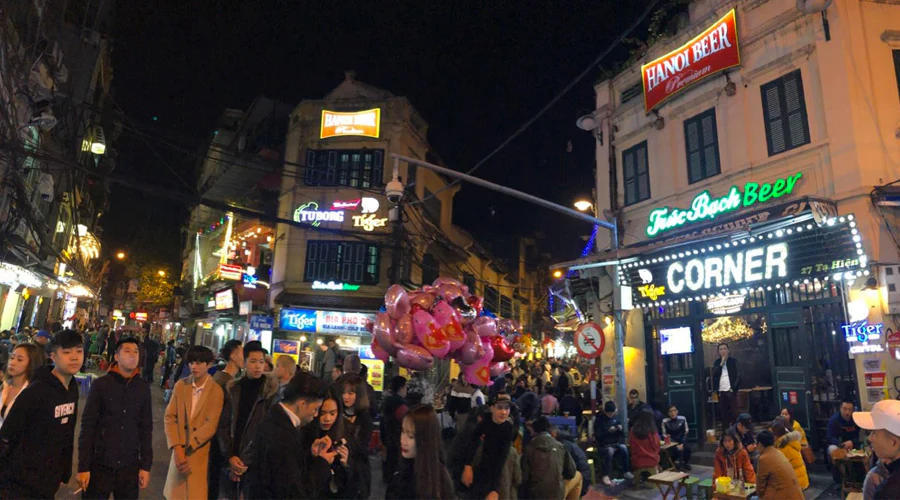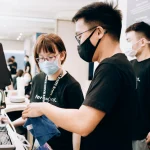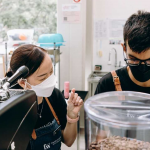I told my friends I’m going on a holiday in Hanoi. “For work or personal?”, my friends joked, insinuating that I’m there just for the coffee for Foreword Coffee’s next coffee source.
“Personal la..” I reassured.
I ended up embarking on an adventure to explore the coffee culture in Hanoi, Vietnam, and this is my take on the specialty coffee culture in this beautiful and rustic city.

Night scene in the Old Quarter of Hanoi
Vietnam has two coffee cultures that run parallel to each other, similar to Singapore’s local kopi culture and our specialty coffee scene. We are familiar with the Vietnamese filter coffee (phin), which uses dark-roasted robusta beans grounded finely, dripped over condense milk, served over ice (optional). This makes a robust, sweet drink that is highly popular with locals and tourists alike. They also have a signature egg coffee “drink”, which can arguably be a dessert, served in many local coffee shops and cafes, each with their own recipe.


Me at Cafe Giang, trying out the famous Egg Coffee in hot and cold styles. The cold one felt more like a dessert as it was thick and rich. The hot version was custardy and sweet.
Specialty coffee in Hanoi, or Vietnam, is unheard of for me. A quick search online revealed some specialty cafes in Hanoi that are worth visiting, and this led me to visit and learn more about the growing specialty coffee scene in Hanoi.
1. GAU Coffee Roasters

2-storey shophouses are a commonplace in Hanoi
On my first night in Hanoi, I popped into GAU Coffee & Bakery as it appeared on my maps, near where my hostel was. This was my first experience with specialty coffee in Hanoi. Within their two-storey cafe lies a coffee roaster, a shelf displaying their in-house roasted beans, and their coffee bar featuring the V60 and espresso machine. GAU Coffee Roasters also bake their own pastries, although a bit expensive at 20,000–40,000 VND apiece.



Bags of freshly roasted coffee beans and their coffee machine there in the cafe 🙂 Note the V60, Chemex, and the Vietnamese phin at the bar.
I ordered a cappuccino for 40,000 VND (S$2.45) and got my cuppa in their takeaway cup which looked hand-drawn by themselves. I was told that the coffee was a Vietnamese arabica blend. “Arabica” is highly prized in the cafes, although the beans may not be of specialty grade.
2. Haka Coffee
I like how cafes in Hanoi close really late at night, like 10pm or 11pm. This gives us more time to explore the city in the day and space the caffeine consumption throughout the day till night!

Interior of Haka Coffee
At Haka Coffee, we tried one of their signature drinks — Wolfberry and Rose Coldbrew — and a good old Americano. The coldbrew was served in a wine glass and didn’t taste like coffee at all. It was sweet with notes of rose (hence the name) and honey, making it a good drink for ladies or if you wanted to trick your brain into thinking that you are not drinking coffee.
I specifically asked for their Vietnamese blend for the Americano and I am highly pleased with the result: sweet and balanced, with caramel notes and little to no bitter ending. A bonus point: the service crew was very attentive to me and my girlfriend, offering us water and describing the drinks to the best that he can, and even told us to tell him if we felt cold sitting outside.

Americano and a coldbrew served in wine glass
You know that these people are not just passionate about the drinks, but also the experience for the customers 🙂
3. D’codes Coffee Lab & Campus Vietnam

Unassuming shopfront with a wealth of treasures inside! D’codes is also in Malaysia, Thailand, and China.
The cafe was crowded with people during lunch. We went for our meal first, before heading back around 2pm, and finally found seats at the bar to watch the baristas do their work and chat with them about their coffee. As I was making my order, I overheard a Singaporean accent, presumably from the boss of the cafe. Later I learnt that the founder of the cafe, Caden, is Malaysian. He shared that the ‘cafe’ is simply for “fun” as he meant for the shophouse to be a coffee academy to increase the knowledge and practice of specialty coffee in Vietnam. D’codes is fairly new in Vietnam, as it was founded in 2017, but the walls of the cafe are already filled with many accolades and SCA certifications.

What coffee do you feel like drinking today?
Two things caught our eyes: the high-tech looking Sanremo espresso machine, and their pictorial menu right above it. The menu makes it easy for customers to decide what they wish to drink without feeling overwhelmed with the different types of coffee. The espresso machine is an overkill, I feel, but it allows those at the bar to see exactly how the espresso was extracted from the display of each grouphead: the temperature, pressure, and time.


My filter coffee served in a tall glass with two tasting cups. Nice wooden tray!
At this point, we came to a conclusion that specialty cafes in Hanoi love to serve their coffee in nice carafes and wooden trays. These extra touches make the whole experience complete 🙂
We chatted a bit with the barista, and she led us to visit a newly-opened cafe. In fact, that day was the cafe’s soft opening day, and she was also about to visit the cafe to support her friends there.. and so we went!
4. Atelier Coffee Roasters

We were told to look out for “the yellow cafe”
This cafe is spanking new. As we were entering Atelier Coffee, the eyes inside were already staring at us as we approached them. Three baristas served us at the cashier and patiently described the drinks as we asked what was each drink about. At the end, we ordered 2 interesting-sounding drinks: Shakerato and the Hatsukoi (“first love” in Japanese).

Shakerato (at the back) and the Hatsukoi (at the front)
That day was Atelier Coffee’s first day of opening. I was told this was the boss’ first foray into the cafe scene, although they already have had experience in coffee roasting for some time. Their coffee blend caught my eye as they used “fine robusta” beans. Has the movement for high-quality robusta taken flight?



Baristas doing their work and the coffee blend which features “fine robusta”.
The Hatsukoi, their signature drink, was confusing at first. It was prepared by pouring espresso into a cup of steamed milk, and the edges of the cup were lined with some salt and pepper. The foam on top was also sprinkled with cinnamon powder. It feels like you are drinking a tequila shot, except this drink is served hot and in a larger vessel (8oz). The first sip was salty and overwhelming with cinnamon. As we continue to enjoy the drink, we tasted more sweet flavours which we suspect came from the edges of the cup.
Upon Googling, we found that Shakerato is a standard drink prepared by espresso shaken with ice cubes. This one that we had tasted sweet, as if honey was added as well. Certainly refreshing and doesn’t taste like coffee.
I bought a bag of their Tropical Lullaby, featuring single-origin arabica coffee from Cau Dat, Dalat. Excited to try it out!
5. Blackbird Coffee


Lovely shopfront and look at the different brewing equipment at the bar!
The barista at D’codes also suggested for us to visit Blackbird Coffee, and I’m so glad we did. This coffee roaster pride themselves on their Vietnamese coffee — both the Arabica and Robusta varieties. They feature only their Vietnamese-grown coffee beans and also offer their arabica coffee made with the Vietnamese filter method. I was intrigued and ordered the same coffee brewed with the V60 and the Vietnamese filter method, just for comparisons.


The Vietnamese filter method used on arabica beans. The menu nicely explained the types of coffee used and brewing methods available.
The V60 version was more balanced and it highlights the fruity flavours of the coffee. The Vietnamese filter method presents the heavier notes but was underextracted at the same time, as the coffee presented a sharp tangy experience that didn’t go well with the coffee. I tried asking the barista the differences between the V60 and the Vietnamese filter method, but didn’t get a satisfactory answer. He emphasized that it was interesting to get people think about using the traditional Vietnamese filter method on arabica, specialty coffee beans, and to think about the coffee culture they have in Vietnam.
6. Kafeville

The cafe was located in a quiet neighbourhood but is still a popular place for locals and tourists.
I thought I’ve had enough coffee for the trip, but just one more specialty cafe to visit before we call it a day, since we were in the neighbourhood of Kafeville, a coffee roaster themselves.


We enjoyed the cascara and the filter coffee 🙂 Seated with a view of the coffee bar, the coffee roaster, and the huge window that shows the outside!
We were greeted with their coffee roaster at the front, next to their shop windows. The baristas were very inviting, and it didn’t take us much time to decide on having a V60 and cascara tea — the first of all these specialty cafes where we saw cascara on their menu!
I bought a bag of their roasted coffee beans, featuring a natural processed Caturra from the Dalat region. Looking forward to trying it too! 🙂
Overall…
It is very prominent that as the coffee entrepreneurs chase towards specialty coffee, they didn’t leave behind their local Vietnamese coffee culture. Most of them, if not all, serve the Vietnamese filter coffee in their cafe as well, and they do not shy away from using robusta beans in their blend. In fact, they take pride in their coffee culture and knowledge, explaining to us how robusta beans provide the body and bolder flavours in the cup of coffee.

View of the Hanoi Old Quarter from the Cong Ca Phe, at its third level outdoor seating.
We asked a barista what she thinks of the local cafe scene, and she told us that come next year, there will be a lot more specialty coffee popping up in Hanoi, and it will be very interesting here. We believe so, and we think this is yet another sign that specialty coffee in the Asian region is gaining traction and we need to support more coffee farmers, ethically, in our region.
I am well-rested and back at work, feeling inspired to do more for Foreword Coffee 🙂 Chat me up through Foreword Coffee’s instagram if you wish to try some of these coffees that I’ve brought back! Look forward to our next post as we conclude the year 2018 and looking Foreword to an exciting 2019.
Cheers.





